2024届高考英语时态、体态、语态的对比与研究课件(共32张PPT)
文档属性
| 名称 | 2024届高考英语时态、体态、语态的对比与研究课件(共32张PPT) |  | |
| 格式 | pptx | ||
| 文件大小 | 915.2KB | ||
| 资源类型 | 教案 | ||
| 版本资源 | 通用版 | ||
| 科目 | 英语 | ||
| 更新时间 | 2023-08-19 23:11:28 | ||
图片预览

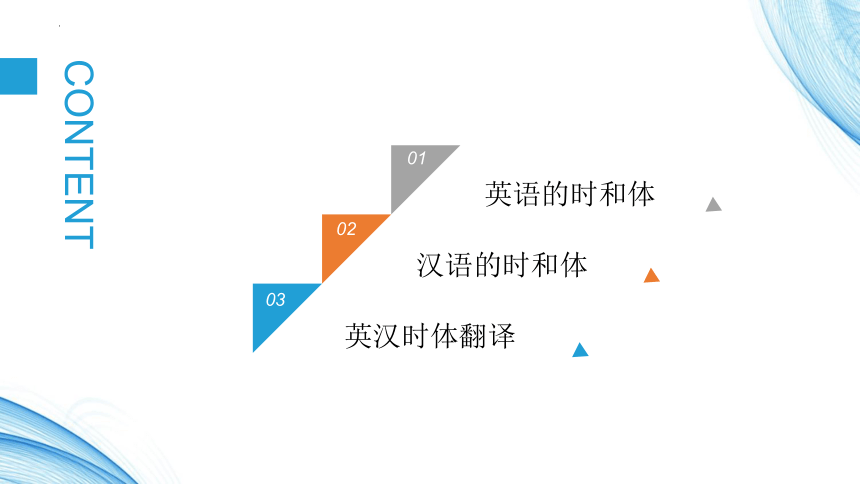
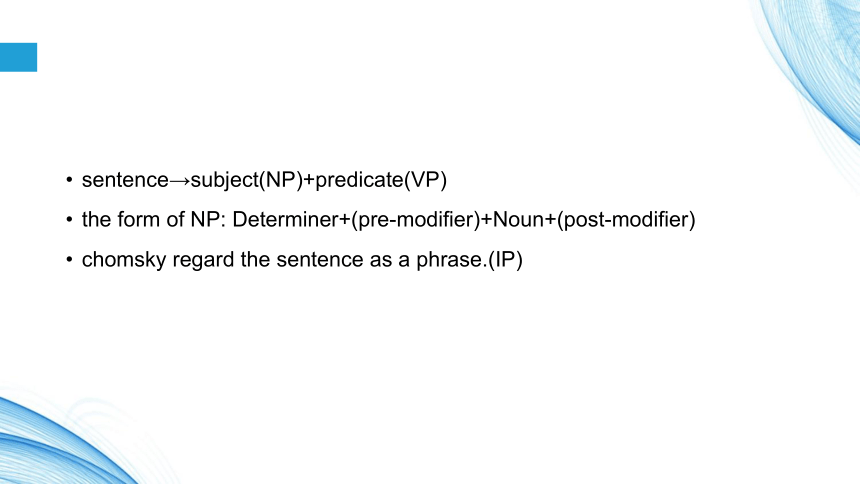

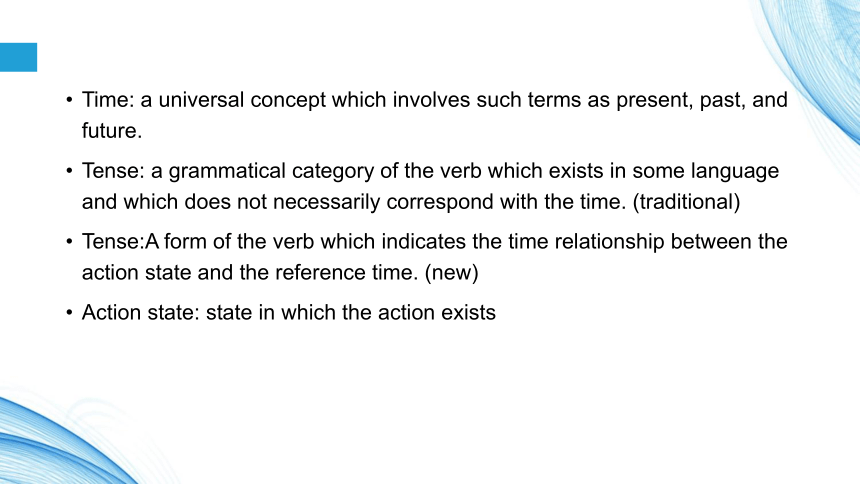
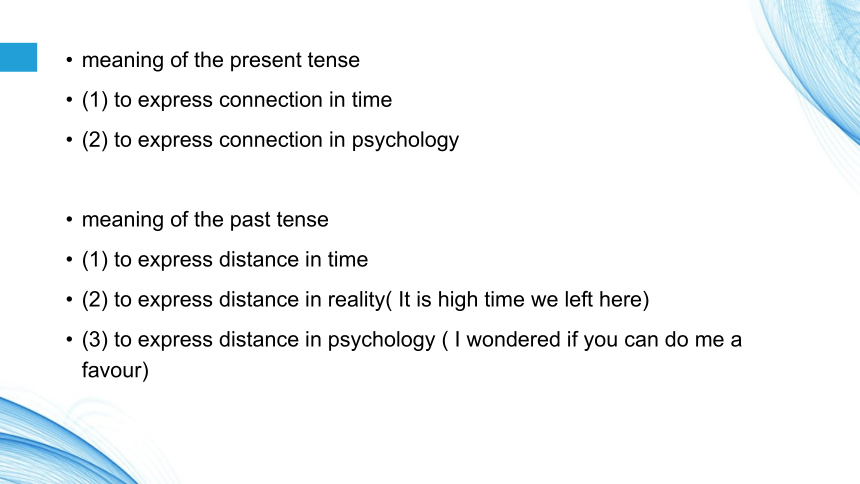

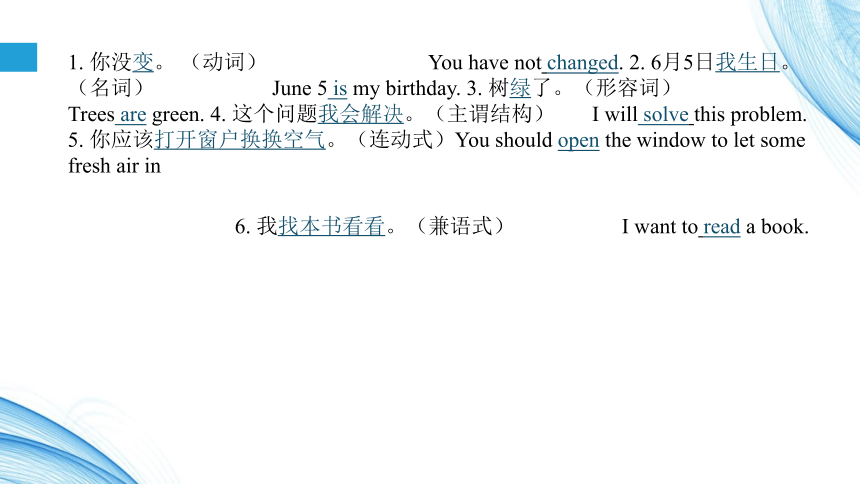
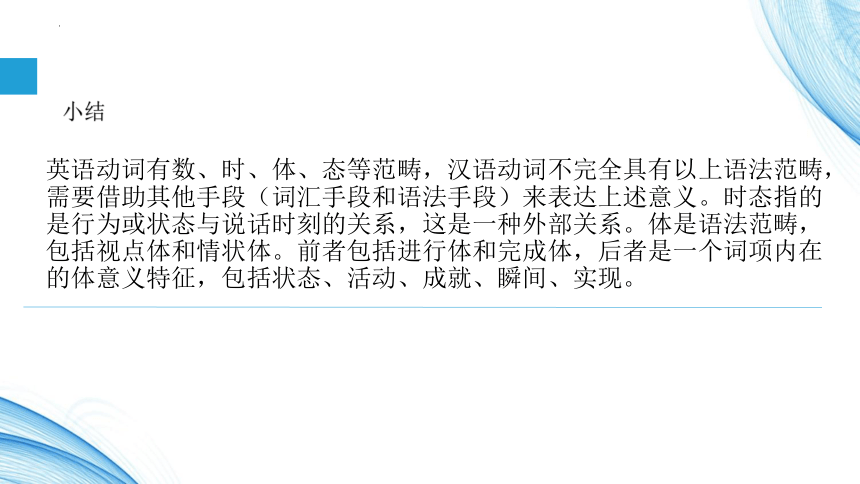


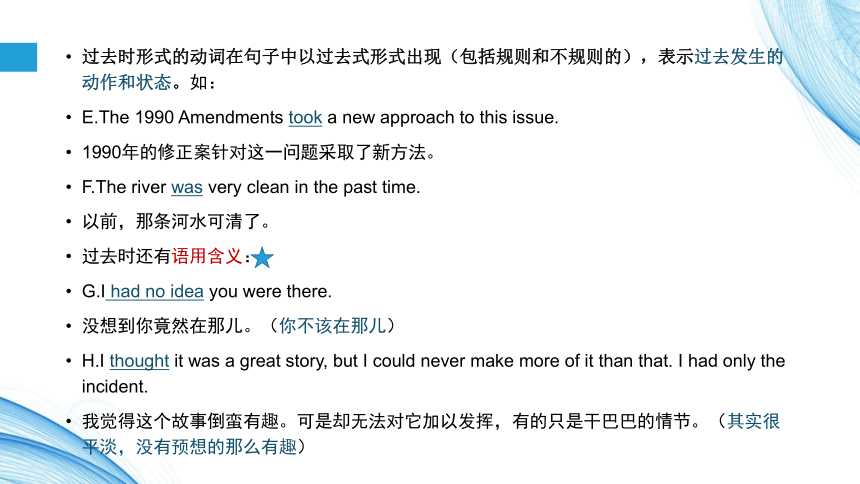
文档简介
(共32张PPT)
时、体、语态
02
汉语的时和体
03
英汉时体翻译
CONTENT
英语的时和体
01
sentence→subject(NP)+predicate(VP)
the form of NP: Determiner+(pre-modifier)+Noun+(post-modifier)
chomsky regard the sentence as a phrase.(IP)
(1) The ten o'clock news says that it is going to be cold.
(2) Last week I am in the sitting room with my wife, when this chap next door staggers past and in a drunken fit throws a brick through our window.
(3) Next year the United Nations celebrates the twenty-fifth anniversary of its charter.
(4) One more step, and I shoot you.
(5) Did you want to see me now.
(6) My wife will be sorry that she missed seeing you this evening.
Time: a universal concept which involves such terms as present, past, and future.
Tense: a grammatical category of the verb which exists in some language and which does not necessarily correspond with the time. (traditional)
Tense:A form of the verb which indicates the time relationship between the action state and the reference time. (new)
Action state: state in which the action exists
meaning of the present tense
(1) to express connection in time
(2) to express connection in psychology
meaning of the past tense
(1) to express distance in time
(2) to express distance in reality( It is high time we left here)
(3) to express distance in psychology ( I wondered if you can do me a favour)
概述
如果不是并列的动作,英语小句一般只允许使用一个谓语动词,这个动词是句子的中心。
汉语小句里的谓语不受形态变化约束,充当谓语的有动词、名词、形容词、主谓结构。
1. 你没变。 (动词) You have not changed. 2. 6月5日我生日。 (名词) June 5 is my birthday. 3. 树绿了。(形容词) Trees are green. 4. 这个问题我会解决。(主谓结构) I will solve this problem. 5. 你应该打开窗户换换空气。(连动式)You should open the window to let some fresh air in
6. 我找本书看看。(兼语式) I want to read a book.
英语动词有数、时、体、态等范畴,汉语动词不完全具有以上语法范畴,需要借助其他手段(词汇手段和语法手段)来表达上述意义。时态指的是行为或状态与说话时刻的关系,这是一种外部关系。体是语法范畴,包括视点体和情状体。前者包括进行体和完成体,后者是一个词项内在的体意义特征,包括状态、活动、成就、瞬间、实现。
小结
1.英语的时和体:时
时是一个语法范畴,是表示时间区别的动词形式。
由此可见,英语的限定动词词组有八种时、体形式。
一般现在时(simple present tense)
一般过去时(simple past tense)
现在进行时(present progressive)
过去进行时(past progressive)
现在完成时(present perfect tense)
过去完成时(past perfect tense)
现在完成进行时(present perfect continuous tense)
过去完成进行时(past perfective continuous tense)
英语动词需要加上时间标记,说明行为/状态发生/出现的时间(现在和过去)。现在时以动词原形或者动词-s形式(第三人称单数现在时,动词后加-s/-es)表示现在发生的动作或状态。如:
A.He seems very tired today.
他今天看起来很累。
现在时也能用来表示其他时间发生的动作或状态。如:
B.Your plane leaves tomorrow morning.
你的航班明天上午起飞。(将来)
注:诸如come, go, leave, arrive, start, get,stay, live, fly等可以用一般现在时表示将来。又如:
The meeting starts at five o’clock.
He gets off at the next stop.
C.The sun rises in the east.
太阳从东方升起。(客观)
D.She walks to school every day.
她每天步行上学。(习惯)
过去时形式的动词在句子中以过去式形式出现(包括规则和不规则的),表示过去发生的动作和状态。如:
E.The 1990 Amendments took a new approach to this issue.
1990年的修正案针对这一问题采取了新方法。
F.The river was very clean in the past time.
以前,那条河水可清了。
过去时还有语用含义:
G.I had no idea you were there.
没想到你竟然在那儿。(你不该在那儿)
H.I thought it was a great story, but I could never make more of it than that. I had only the incident.
我觉得这个故事倒蛮有趣。可是却无法对它加以发挥,有的只是干巴巴的情节。(其实很平淡,没有预想的那么有趣)
同样,过去时形式也能用来表示其他时间出现的动作或状态。如:
a.If I were you, I would go at once.
如果我是你,我马上就会去。(虚拟语气,表示现在)
b.If there were no air, people would die.
如果没有空气,人就会死亡。(虚拟语气,表示现在)
c.It is time we set aside this adolescent nit-picking at our differences and began to think of ourselves as a human family, alike in more ways than we are dissimilar.
别再年轻气盛,对你我之间的差异吹毛求疵了;现在就开始想想,我们人类本是一家,相似总是大于差异。(虚拟语气,表示将来)
英语中表达将来时间的语法手段有will/shall+不定式、will/shall be+V-ing、be going to+不定式、be+V-ing、be to+不定式,以及用一般现在时表达将来时间。
Eg: Without enough engineers and strong science education in our school systems, none of us is going to have a successful economy in the high-technology era ahead of us.
如果我们没有足够的工程师,在我们学校中没有强有力的科学教育,那么,在未来技术高度发达的时代,我们就不可能建设繁荣的经济。
有时候,一般现在时也可以表达将来的意义,但通常是指按计划或日程将来会发生的事情。如:
Your plane leaves tomorrow morning.你乘坐的飞机明天起飞。(前面有讲过)
英语的时和体:体
体是一个语法范畴,是表示动作或过程在一定时间内处于何种状态的动词形式。英语动词有两个体,进行体和完成体。有进行体和完成体
进行体由be+V-ing 形式表达,是从内部观察某一情状,着眼点是其内部过程,而不涉及事件的起始或终结。动词的进行体不断衍生出新的表意功能。如:
a.The bus is stopping.
车要停了。车正在停。
b.I'm hoping you'll give us some advice.
就等着您提点建议了。
c.I guess I'm going to say this because I'm being honest about everything. The woman he's married to had two daughter.
我嘴里藏不住活儿,还是说出来吧。他娶的那位太太已经有俩女儿了。
d.You can't just keep saying no. You're being rude.
不要老是不不的。这样多不礼貌。
完成体将某一动词情景看成不可分割的整体,不区分构成这个动词情景的各个阶段。由助动词have加动词的过去分词,即“have+过去分词”表达,如:
e.They have docked us of two days of our annual leave.
他们把我们年假扣减了两天。
f.He had devoted his whole life to the study of contemporary art.
他把一生都献给了当代艺术研究。
英语的时与体:语态
语态是一个语法范畴,表示主语和谓语动词之间的主动或被动关系的语法形式。英语动词有两种语态:主动态和被动态。
被动态可以由助动词be的一定形式加及物动词的-ed分词构成。
被动语态也有不同的时体形式:
一般现在时 The boy is regarded as brilliant
一般过去时 This book was published in 1998.
现在进行时 The visitors are being met at the
过去进行时 He told me that the machine was being repaired.
现在完成时 The car has been repaired.
过去完成时 Last month, the new road had been opened to traffic.
2.汉语的时和体
汉语是汉藏语系,有着和英语等印欧语系截然不同的时体分类,认识英汉时体分类的异同有助于对汉语时体的语义解释。汉语中常常标记“了”“过”“在”“着”“起来”“下去”等作为表达时体的手段。
A1.他明天来。
He will come tomorrow.
A2.他昨天去的北京。
He went to Beijing yesterday.
从上述例子可以看到,在汉语表达时间时,句子层面出现了表达过去、现在或将来的词,但是动词本身没有发生任何变化,而英语用的时间词动词有形式变化,如will、be going to一类表示将来,-ed表示过去。因此,汉语里动词不带有时间信息,表达时间主要使用词汇手段和语法手段。汉语中有一些专门表示各种时间的名词和副词:“昨天”“刚才”“在那之前”表示过去,“现在”“正”表示现在,“明天”“马上”表示将来。
如:
B1.他写了两篇论文。(完成)
He has completed two essays.
B2.他要写论文。(将来)
He will write an essay.
B3.他每天写论文。(习惯动作)
He writes essays every day.
汉语里用语法手段表达时间,如时态助词或语气助词。时态助词有“过”“来着”“了”“的”表示过去,语气助词如“呢”“着”“吗”“吧”
Eg:The difficulties have been overcome, and the problem solved.
困难克服了,问题也解决了。
Don’t you see Hell is empty. All the devils are here.
你还不明白吗?地狱已经空无一人。所有的恶魔都已潜伏到我们身边。
They have docked us of two days of our annual leave.
他们把我们年假扣减了两天。
He had devoted his whole life to the study of contemporary art.
他把一生都献给了当代艺术研究。
I guess I’m going to say this because I’m being honest about everything.
我嘴里藏不住话儿,还是说出来吧。
汉语中存在大量的无时间标记的句子,这说明其时间因素也可以是隐含的,句子中不出现显性的词汇标记或语法标记。
如:
我喜欢看电视。
I like watching TV.
我给你寄一封信,你收到没有?
I sent a letter for you. Have you received it
3.英汉时体的翻译
1.对译
指不改变原文结构,仅在必要时调整语序的翻译方法。是最简单、最基本、最有效、实用的翻译方法,也是用的最多的翻译方法。
The reason why I’m calling you now is that I’d like to see you urgently.
我现在打电话给你是因为我想立刻见你。
He was talking in his sleep and moving uneasily on the bed.
他一边说梦话,一边在床上不安地辗转反侧。
2.转译
在英汉翻译中,转换时用得最广泛的变通手段。所谓转与换是指转移和调换原作信息,力求信息量不变,即形式转换,意义力求不变。基于之前对于这个翻译方法已经有所了解,有关词类转译如:名词转译为动词,或者形容词转译为动词等等不是本次重点。整个部分是基于时和体的,所以这里转译围绕了“时和体”列举例子展开。
A.进行体有时指将来
If you are using Microsoft Windows XP SP2 or a higher version, your operating system has a built-in firewall.
要是你用的是Window XP SP2或者更高版本,操作系统中就有内置的防火墙。
If you’re walking the dog, take the time to admire an azalea bush in bloom.
若是出门遛狗,就花点时间欣赏一下盛开的丛丛杜鹃吧。
B.进行体表达某段时间内出现的状态变化,且变化有一个过程。
The weather is getting cold.
天气越来越冷了。
C.进行体表达状态变化,但变化没有过程。
(进行体由be+V-ing 形式表达,是从内部观察某一情状,着眼点是其内部过程,而不涉及事件的起始或终结。)
The old order is dying but that the new order has not yet been born.
旧秩序行将就木,新秩序尚未产生。
The coral reefs are dying.
珊瑚礁日近消亡。
D.汉语有些词语本身就有进行的意思,不需要加“进行”标志。
Prices are stale and the market is flourishing.
物价平稳,市场繁荣。
练习:
1.The smell of wild flowers came to us on the light breeze that was blowing.
2. “Frike!”cried Azzie. “I thought you had deserted me.” “Nay, master,” Frike said, “I would not dream of it.”
3.I don't believe that an innate skill or talent can be modelled, because people have tried to model me, and at first I thought it could be done, but I just don't think it can be done.
4.The government has taken a measure to maintain the stability of prices.
5.I don't know what you are talking about.
6.I remember my grandfather was always smoking a cigar.
答案:
1.野花的芬芳乘着清风向我们扑来。
2.阿兹喊道:“弗莱克,原来你没有抛下我不管。”“怎么会呢,主人。我从没想那样。”弗莱克答道。
3.我认为天生的技艺或才能没法模仿。有人试图模仿我,当时我以为这样能行,现在知道这根本行不通。
4.政府已经采取措施确保物价稳定。
5.我不知道你在说什么。
6.我记得爷爷总是叼着根雪茄。
参考文献
易仲良教授系列论文
秦裕祥教授系列论文
秦裕祥教授《英语语法专题研究》
敬请批评指正
THANK YOU FOR YOUR TIME
时、体、语态
02
汉语的时和体
03
英汉时体翻译
CONTENT
英语的时和体
01
sentence→subject(NP)+predicate(VP)
the form of NP: Determiner+(pre-modifier)+Noun+(post-modifier)
chomsky regard the sentence as a phrase.(IP)
(1) The ten o'clock news says that it is going to be cold.
(2) Last week I am in the sitting room with my wife, when this chap next door staggers past and in a drunken fit throws a brick through our window.
(3) Next year the United Nations celebrates the twenty-fifth anniversary of its charter.
(4) One more step, and I shoot you.
(5) Did you want to see me now.
(6) My wife will be sorry that she missed seeing you this evening.
Time: a universal concept which involves such terms as present, past, and future.
Tense: a grammatical category of the verb which exists in some language and which does not necessarily correspond with the time. (traditional)
Tense:A form of the verb which indicates the time relationship between the action state and the reference time. (new)
Action state: state in which the action exists
meaning of the present tense
(1) to express connection in time
(2) to express connection in psychology
meaning of the past tense
(1) to express distance in time
(2) to express distance in reality( It is high time we left here)
(3) to express distance in psychology ( I wondered if you can do me a favour)
概述
如果不是并列的动作,英语小句一般只允许使用一个谓语动词,这个动词是句子的中心。
汉语小句里的谓语不受形态变化约束,充当谓语的有动词、名词、形容词、主谓结构。
1. 你没变。 (动词) You have not changed. 2. 6月5日我生日。 (名词) June 5 is my birthday. 3. 树绿了。(形容词) Trees are green. 4. 这个问题我会解决。(主谓结构) I will solve this problem. 5. 你应该打开窗户换换空气。(连动式)You should open the window to let some fresh air in
6. 我找本书看看。(兼语式) I want to read a book.
英语动词有数、时、体、态等范畴,汉语动词不完全具有以上语法范畴,需要借助其他手段(词汇手段和语法手段)来表达上述意义。时态指的是行为或状态与说话时刻的关系,这是一种外部关系。体是语法范畴,包括视点体和情状体。前者包括进行体和完成体,后者是一个词项内在的体意义特征,包括状态、活动、成就、瞬间、实现。
小结
1.英语的时和体:时
时是一个语法范畴,是表示时间区别的动词形式。
由此可见,英语的限定动词词组有八种时、体形式。
一般现在时(simple present tense)
一般过去时(simple past tense)
现在进行时(present progressive)
过去进行时(past progressive)
现在完成时(present perfect tense)
过去完成时(past perfect tense)
现在完成进行时(present perfect continuous tense)
过去完成进行时(past perfective continuous tense)
英语动词需要加上时间标记,说明行为/状态发生/出现的时间(现在和过去)。现在时以动词原形或者动词-s形式(第三人称单数现在时,动词后加-s/-es)表示现在发生的动作或状态。如:
A.He seems very tired today.
他今天看起来很累。
现在时也能用来表示其他时间发生的动作或状态。如:
B.Your plane leaves tomorrow morning.
你的航班明天上午起飞。(将来)
注:诸如come, go, leave, arrive, start, get,stay, live, fly等可以用一般现在时表示将来。又如:
The meeting starts at five o’clock.
He gets off at the next stop.
C.The sun rises in the east.
太阳从东方升起。(客观)
D.She walks to school every day.
她每天步行上学。(习惯)
过去时形式的动词在句子中以过去式形式出现(包括规则和不规则的),表示过去发生的动作和状态。如:
E.The 1990 Amendments took a new approach to this issue.
1990年的修正案针对这一问题采取了新方法。
F.The river was very clean in the past time.
以前,那条河水可清了。
过去时还有语用含义:
G.I had no idea you were there.
没想到你竟然在那儿。(你不该在那儿)
H.I thought it was a great story, but I could never make more of it than that. I had only the incident.
我觉得这个故事倒蛮有趣。可是却无法对它加以发挥,有的只是干巴巴的情节。(其实很平淡,没有预想的那么有趣)
同样,过去时形式也能用来表示其他时间出现的动作或状态。如:
a.If I were you, I would go at once.
如果我是你,我马上就会去。(虚拟语气,表示现在)
b.If there were no air, people would die.
如果没有空气,人就会死亡。(虚拟语气,表示现在)
c.It is time we set aside this adolescent nit-picking at our differences and began to think of ourselves as a human family, alike in more ways than we are dissimilar.
别再年轻气盛,对你我之间的差异吹毛求疵了;现在就开始想想,我们人类本是一家,相似总是大于差异。(虚拟语气,表示将来)
英语中表达将来时间的语法手段有will/shall+不定式、will/shall be+V-ing、be going to+不定式、be+V-ing、be to+不定式,以及用一般现在时表达将来时间。
Eg: Without enough engineers and strong science education in our school systems, none of us is going to have a successful economy in the high-technology era ahead of us.
如果我们没有足够的工程师,在我们学校中没有强有力的科学教育,那么,在未来技术高度发达的时代,我们就不可能建设繁荣的经济。
有时候,一般现在时也可以表达将来的意义,但通常是指按计划或日程将来会发生的事情。如:
Your plane leaves tomorrow morning.你乘坐的飞机明天起飞。(前面有讲过)
英语的时和体:体
体是一个语法范畴,是表示动作或过程在一定时间内处于何种状态的动词形式。英语动词有两个体,进行体和完成体。有进行体和完成体
进行体由be+V-ing 形式表达,是从内部观察某一情状,着眼点是其内部过程,而不涉及事件的起始或终结。动词的进行体不断衍生出新的表意功能。如:
a.The bus is stopping.
车要停了。车正在停。
b.I'm hoping you'll give us some advice.
就等着您提点建议了。
c.I guess I'm going to say this because I'm being honest about everything. The woman he's married to had two daughter.
我嘴里藏不住活儿,还是说出来吧。他娶的那位太太已经有俩女儿了。
d.You can't just keep saying no. You're being rude.
不要老是不不的。这样多不礼貌。
完成体将某一动词情景看成不可分割的整体,不区分构成这个动词情景的各个阶段。由助动词have加动词的过去分词,即“have+过去分词”表达,如:
e.They have docked us of two days of our annual leave.
他们把我们年假扣减了两天。
f.He had devoted his whole life to the study of contemporary art.
他把一生都献给了当代艺术研究。
英语的时与体:语态
语态是一个语法范畴,表示主语和谓语动词之间的主动或被动关系的语法形式。英语动词有两种语态:主动态和被动态。
被动态可以由助动词be的一定形式加及物动词的-ed分词构成。
被动语态也有不同的时体形式:
一般现在时 The boy is regarded as brilliant
一般过去时 This book was published in 1998.
现在进行时 The visitors are being met at the
过去进行时 He told me that the machine was being repaired.
现在完成时 The car has been repaired.
过去完成时 Last month, the new road had been opened to traffic.
2.汉语的时和体
汉语是汉藏语系,有着和英语等印欧语系截然不同的时体分类,认识英汉时体分类的异同有助于对汉语时体的语义解释。汉语中常常标记“了”“过”“在”“着”“起来”“下去”等作为表达时体的手段。
A1.他明天来。
He will come tomorrow.
A2.他昨天去的北京。
He went to Beijing yesterday.
从上述例子可以看到,在汉语表达时间时,句子层面出现了表达过去、现在或将来的词,但是动词本身没有发生任何变化,而英语用的时间词动词有形式变化,如will、be going to一类表示将来,-ed表示过去。因此,汉语里动词不带有时间信息,表达时间主要使用词汇手段和语法手段。汉语中有一些专门表示各种时间的名词和副词:“昨天”“刚才”“在那之前”表示过去,“现在”“正”表示现在,“明天”“马上”表示将来。
如:
B1.他写了两篇论文。(完成)
He has completed two essays.
B2.他要写论文。(将来)
He will write an essay.
B3.他每天写论文。(习惯动作)
He writes essays every day.
汉语里用语法手段表达时间,如时态助词或语气助词。时态助词有“过”“来着”“了”“的”表示过去,语气助词如“呢”“着”“吗”“吧”
Eg:The difficulties have been overcome, and the problem solved.
困难克服了,问题也解决了。
Don’t you see Hell is empty. All the devils are here.
你还不明白吗?地狱已经空无一人。所有的恶魔都已潜伏到我们身边。
They have docked us of two days of our annual leave.
他们把我们年假扣减了两天。
He had devoted his whole life to the study of contemporary art.
他把一生都献给了当代艺术研究。
I guess I’m going to say this because I’m being honest about everything.
我嘴里藏不住话儿,还是说出来吧。
汉语中存在大量的无时间标记的句子,这说明其时间因素也可以是隐含的,句子中不出现显性的词汇标记或语法标记。
如:
我喜欢看电视。
I like watching TV.
我给你寄一封信,你收到没有?
I sent a letter for you. Have you received it
3.英汉时体的翻译
1.对译
指不改变原文结构,仅在必要时调整语序的翻译方法。是最简单、最基本、最有效、实用的翻译方法,也是用的最多的翻译方法。
The reason why I’m calling you now is that I’d like to see you urgently.
我现在打电话给你是因为我想立刻见你。
He was talking in his sleep and moving uneasily on the bed.
他一边说梦话,一边在床上不安地辗转反侧。
2.转译
在英汉翻译中,转换时用得最广泛的变通手段。所谓转与换是指转移和调换原作信息,力求信息量不变,即形式转换,意义力求不变。基于之前对于这个翻译方法已经有所了解,有关词类转译如:名词转译为动词,或者形容词转译为动词等等不是本次重点。整个部分是基于时和体的,所以这里转译围绕了“时和体”列举例子展开。
A.进行体有时指将来
If you are using Microsoft Windows XP SP2 or a higher version, your operating system has a built-in firewall.
要是你用的是Window XP SP2或者更高版本,操作系统中就有内置的防火墙。
If you’re walking the dog, take the time to admire an azalea bush in bloom.
若是出门遛狗,就花点时间欣赏一下盛开的丛丛杜鹃吧。
B.进行体表达某段时间内出现的状态变化,且变化有一个过程。
The weather is getting cold.
天气越来越冷了。
C.进行体表达状态变化,但变化没有过程。
(进行体由be+V-ing 形式表达,是从内部观察某一情状,着眼点是其内部过程,而不涉及事件的起始或终结。)
The old order is dying but that the new order has not yet been born.
旧秩序行将就木,新秩序尚未产生。
The coral reefs are dying.
珊瑚礁日近消亡。
D.汉语有些词语本身就有进行的意思,不需要加“进行”标志。
Prices are stale and the market is flourishing.
物价平稳,市场繁荣。
练习:
1.The smell of wild flowers came to us on the light breeze that was blowing.
2. “Frike!”cried Azzie. “I thought you had deserted me.” “Nay, master,” Frike said, “I would not dream of it.”
3.I don't believe that an innate skill or talent can be modelled, because people have tried to model me, and at first I thought it could be done, but I just don't think it can be done.
4.The government has taken a measure to maintain the stability of prices.
5.I don't know what you are talking about.
6.I remember my grandfather was always smoking a cigar.
答案:
1.野花的芬芳乘着清风向我们扑来。
2.阿兹喊道:“弗莱克,原来你没有抛下我不管。”“怎么会呢,主人。我从没想那样。”弗莱克答道。
3.我认为天生的技艺或才能没法模仿。有人试图模仿我,当时我以为这样能行,现在知道这根本行不通。
4.政府已经采取措施确保物价稳定。
5.我不知道你在说什么。
6.我记得爷爷总是叼着根雪茄。
参考文献
易仲良教授系列论文
秦裕祥教授系列论文
秦裕祥教授《英语语法专题研究》
敬请批评指正
THANK YOU FOR YOUR TIME
